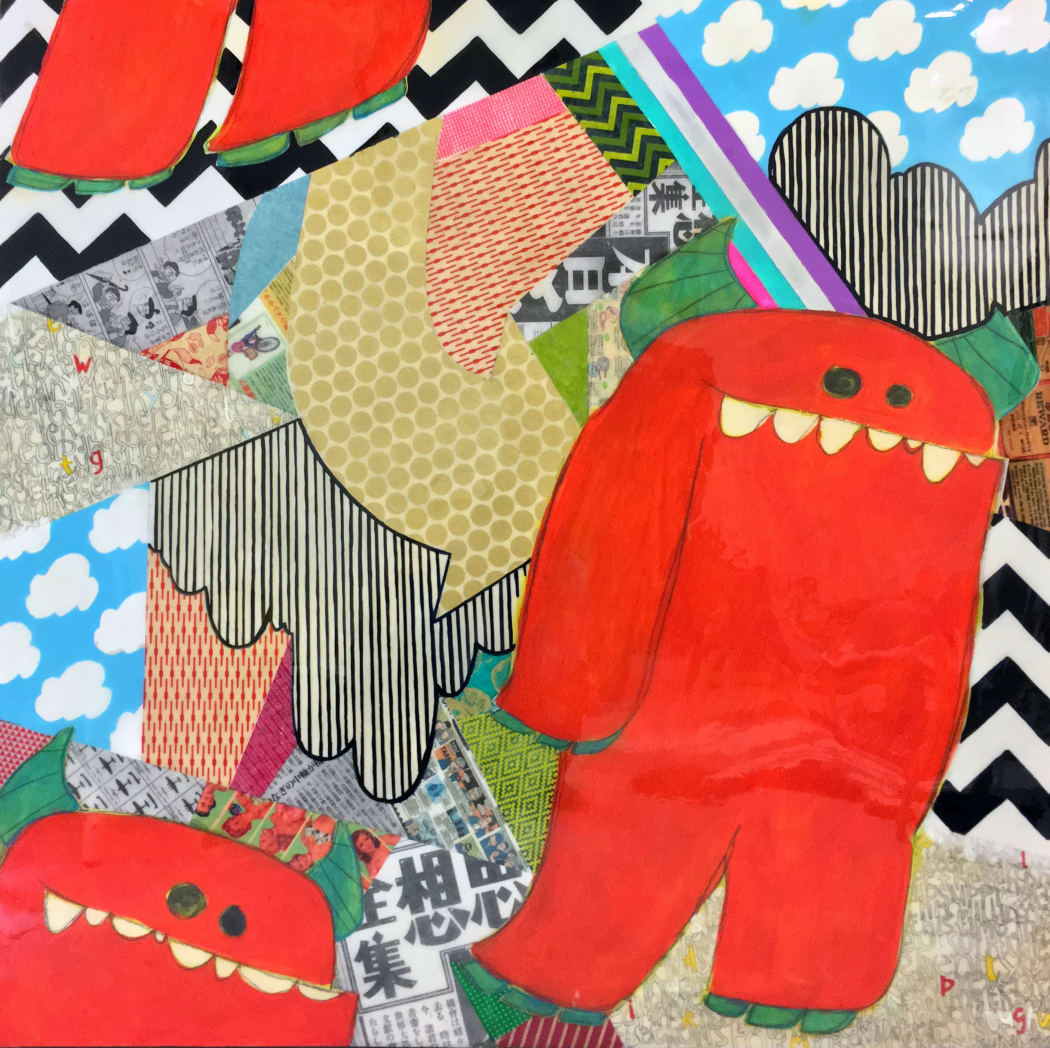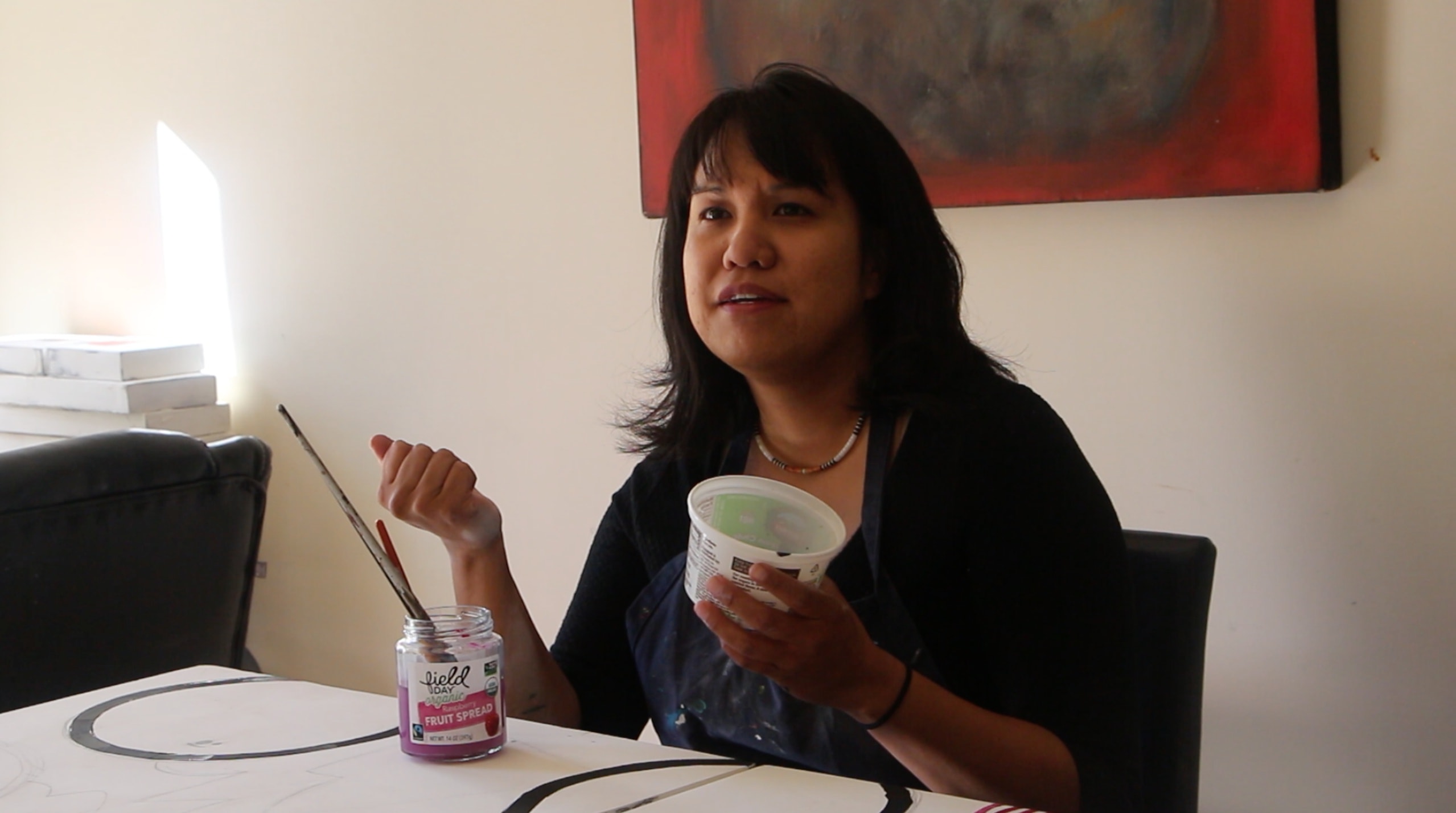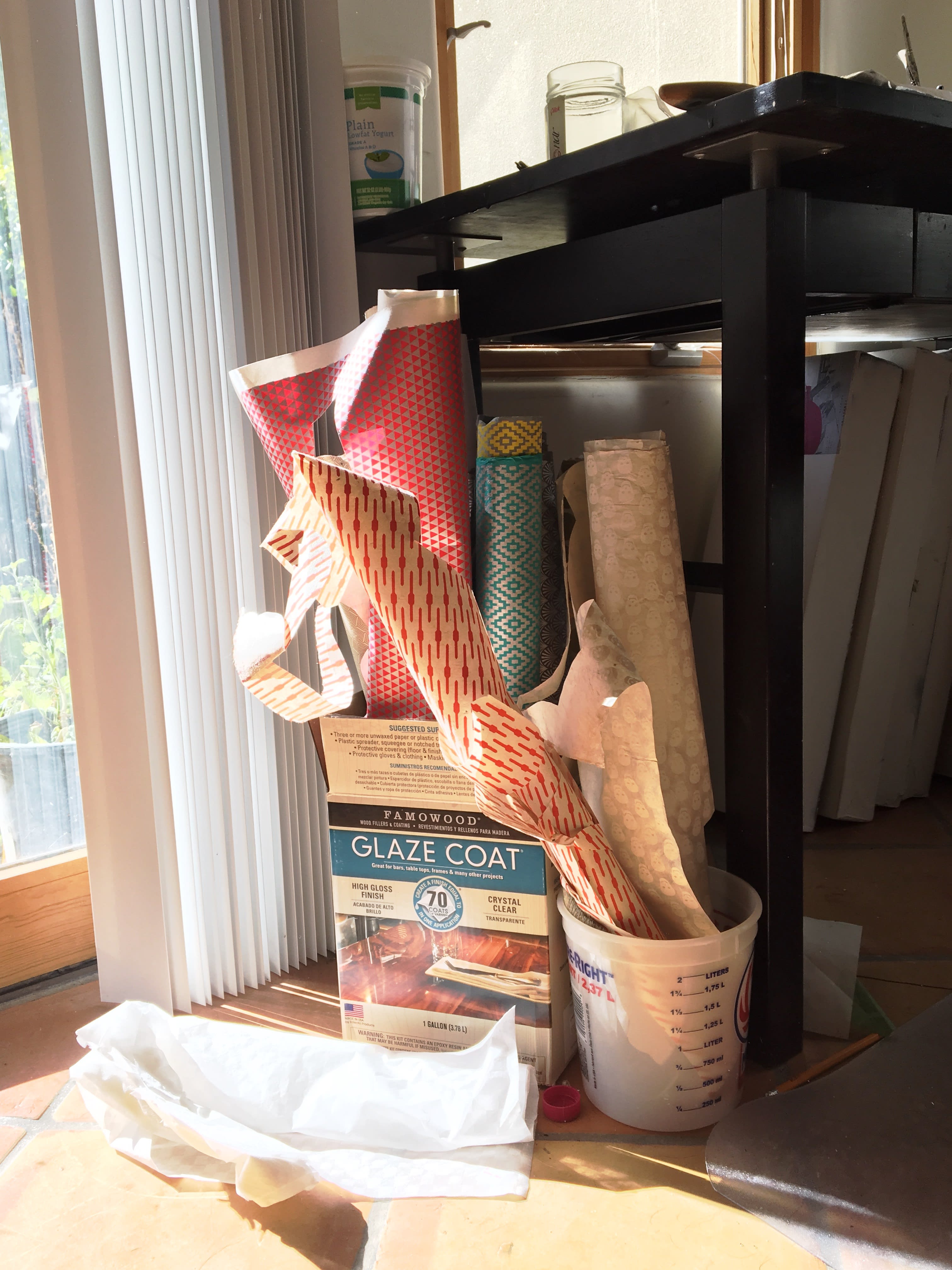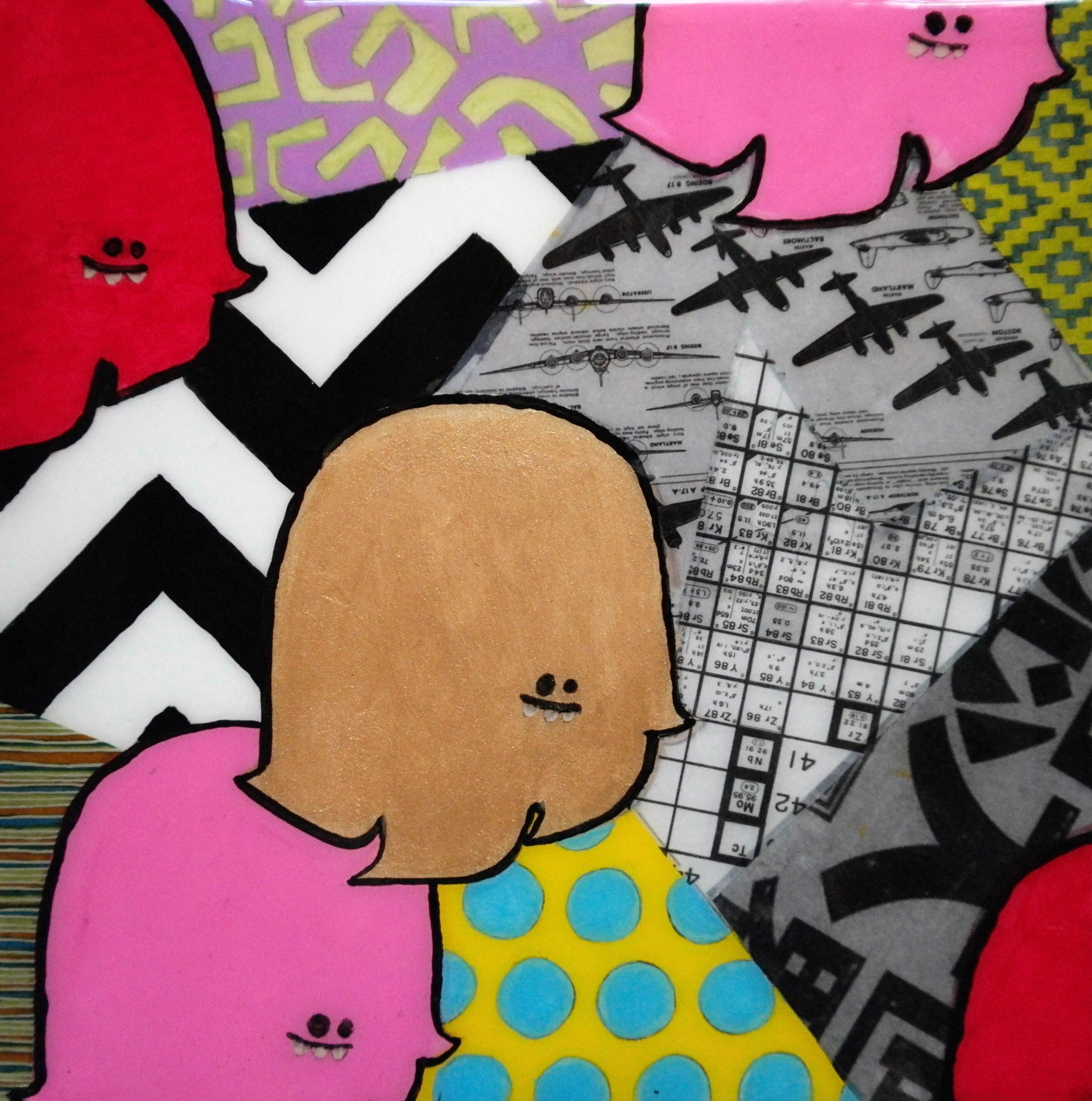
“My sons had this intense Titanic phase. Everything was Titanic,” says Heidi Brandow. She’s showing us around her living room, which hosts a family lineage of artworks. Just below a long, colorful mixed media piece by Brandow, there’s a row of smaller panels featuring soldiers, science fiction characters and the Unsinkable Ship. “Zozobra is another big influence,” Heidi says. “They’ve done Star Wars, World War I, World War II.”
Heidi’s sons have inherited her ability to distill myriad cultural influences into playful, powerful creations. The Santa Fe artist hails from a long line of Native Hawaiian singers, musicians and performers on her mother’s side, and Dinè storytellers and medicine people on her father’s side. Her pursuit of an artistic career came naturally; she is a graduate of the Institute of American Indian Arts, and has studied design at the Harvard Graduate School of Design and the Istanbul Technical University.
In her adventures across the country and around the globe, Heidi has discovered a vast multicultural palette from which she draws aesthetic and conceptual inspiration. She has a long-running series of mixed media panels that feature mischievous monsters, which point to the Superflat movement and street art aesthetics. Another series chronicles our interactions with the Internet to explore contemporary conceptions of virtual reality.
“I knew from an early age that our native identity is so rich that we shouldn’t just hold it to a specific ceremony or spiritual practice,” Heidi says. “In my eyes, art is a tool that helps mark history, time, place and memory. Who’s to say pop culture, and Facebook and Instagram, are not equally as important as star sticks that were made a long time ago to track the different star patterns?” As she works on a new composition at her dining room table, Heidi discusses her cultural heritage, her diverse influences, and the unique motivations behind her varied artistic pursuits:

I’ll often just start composing directly on the panel. I might do some light sketching if it’s a figure or character that I haven’t used before, just to get an idea of what that would look like. Generally, I do all of it on the surface.
This series is a really nice way for me to utilize these characters or images that I’ve been working with for a long time, and try to superimpose them, or make them work with these crazy, mixed-up patterns.
How do you dream up these characters?
Initially, all of them came out of sketches. I grew up in Hawaii, and there’s a huge Asian and Japanese influence there. That environment exposed me to this aesthetic that I really loved. Everything from their candy wrappers to their sodas to their magazines had this bubble gum kind of appeal. There are all of these insane, weird characters, but also very simplified forms. That’s something that just never left me. Over the years, I would create these little guys, and keep this ongoing sketchbook of them. It wasn’t until about 13 years ago that I finally decided to start making work with them, rather than just doing it as a fun thing.
Do the monsters have names, or story lines?
For me personally, they don’t have names, and there’s no story behind any of them. I try not to put too much of my own self into them. I don’t want to over personalize it. These are a nice outlet for me to create work that is lighthearted, that is easy. It’s very fluid. I feel like when people see it, they get it immediately. Whether you like it or you don’t like it, it’s a visceral thing. It’s not too theory-based.
I want my work to reach everyone. I don’t come from a community or people that are heavy academicians. In fact, I would argue that the art world has largely blocked out people of color from participating in art to a large extent.
On the other hand, I think a lot of the work I do is a little heavier. This is a nice outlet, where I can just make work that is more lighthearted and fun.

All of the works in this series feature collage elements. Where do you source your materials?
A lot of times if I’m traveling, I’ll try to collect papers from wherever I’m going or wherever I’ve been. It could be anything. I like to accumulate stuff from wherever we go, because I feel like when I add that to the pieces, they’re a little footprint. At least for me, they leave some traces of places that I’ve been or experiences I may have had. Of course, some of them may be directly referencing a specific period, or I just like the way it looks.
It sounds like there’s some autobiographical significance to your work, but it’s subtle.
I have such a weird thing about this personal narrative situation. When I was in college studying art—I don’t know how everybody teaches, or what other programs look like—but I feel like that whole narrative thing was so abused. I get it that these are tools that people use to create meaning, and maybe that meaning comes from very personal experiences. But I don’t know that everything has to be that way.
I feel like a lot of female artists, maybe they’re held up to a little bit more of a, “Well, she’s female so it must have some kind of narrative. It must mean something. It must have this intense personal story.” Are we asking the same questions with male artists? I guess I’m just at odds with it. I question it a lot.
You are a descendant of musicians and storytellers. Is there a performative element to your art practice?
I do like interacting with people. I’ll talk to my clients, or interact with people at events. I’m often really surprised at the people that I meet. I’m really excited when I see that the demographic of people that are into it is so broad. To be able to create work that transcends those cultural and social and economic boundaries, that’s what I want. I think that’s why I’m surprised. I’m like, “Wow, this old man’s into it, that little kid’s into it. Let’s hang out!”
When I meet some of them, I’m like, “Wow, we would never, ever talk in any other context.” Maybe that’s a purely economic situation or something. This is what it’s about, is making those connections, breaking down those barriers, being a part of something that makes people feel happy, feel satisfied. That fuels the stuff that I do.
How does your own cultural heritage figure into your work?
I never entered the art scene on the basis of promoting myself or my work as Native art. Not because I was shying away from it, but because my idea of Native art was a lot of very cultural referenced work, such as very specific tribal motifs and designs. The stuff that I was doing wasn’t like that. I never felt weird about it, because I always felt like my Native identity is already in this work, whether or not there’s symbols or direct references to cultural place. The simple fact that I’m Native and that this is the work that I’m making, there’s no way of denying my heritage and my experience, or saying that it’s not implicitly in the work. I don’t believe it has to have direct references to culture and place.
Culturally Native people are so diverse and our experience is so diverse. If you look at someone like myself, being Native Hawaiian and Navajo or Dinè, they’re two entirely different cultures. They’re both Native, but it’s ocean and desert people. That’s only the first difference, right? Of course we have a lot of similar cultural values, but it’s like night and day in a lot of ways.

Heidi Brandow, These Ghosts These Days, mixed-media, 10 x 10 x 3 in.
What are some of your contemporary influences?
I really love Takashi Murakami, and the whole Superflat movement. I follow a few street artists on Instagram. One of them is a guy I discovered in Turkey, maybe three years ago. His name on Instagram is Leo Lunatic, and he repeatedly uses this Panda icon. You’ll see it all over Istanbul. I started documenting these, so every time I go back, I’ll find new ones.
I feel like in some ways he’s doing similar things to what I’m doing. He uses this icon of a panda, which we all associate as being cute and cuddly and friendly. But they all have this grimace. There’s this weird, almost suspicious nature about them. I like that play on something that looks really cute, but then you’re like, ‘Well, I don’t know.’ He’s really on top of trends and design, so I see him incorporating a lot of different patterns into his work recently.
Tell us more about your artistic pursuits in Turkey.
My relationship with Turkey is pretty intense. It’s a place that I love. I would even go so far as to say that I consider it my second home. The friends and people that I’ve met there are amazing, and there’s many places that I love when I’m there. Moreover, I feel like that region, those people, have such a respect for Native people. I think that’s why I feel this connection with them. I think it was important to make that connection between people that are displaced and understanding that my heritage, my cultural background, isn’t that far removed from their experience in a way.
I recently worked on a photography project in Turkey. In one of my visits a few years ago, I was really struck by how many refugees were living there in the streets. It just broke my heart. The most troubling thing was that back here, nobody knew this was going on. I remember I went to go pick up my sons one day, and I was telling their friend’s mom about it. I was like, “I have to go work on this photo project in Turkey, and I’m going to be documenting refugees.” She was like, “What do you mean?” She had zero idea that this was happening.
I feel like Native people to a certain extent have been refugees in their own homeland, and there’s a lot of forced migration that’s happened. You only have to go back two generations, to our great grandparents. It’s that solidarity of knowing that history, and feeling like, “Wow, this is happening in real time to people.” I get it, I see that, and I want other people to know that.
So I took this really heavy topic, and tried to find a way to relate it to anyone. I had the refugees talk about their definitions of home. That’s such an easy idea to relate to, and it means several things to everyone. It was a way to get the conversation going. Maybe I don’t necessarily impose my own narrative on the work that I’m creating, but I collect a lot of things from other people and use it in my work, or use it to inspire me to create more work. I love hearing other people’s stories.
At the other end of the spectrum from these real world issues, you’ve been exploring virtual reality in your work.
This body of work, which is still untitled, is dealing with the concept of virtual reality. I started using these diagram images in my work a few years ago. I studied industrial design, and that background really influenced my work. It gave me an interest in these diagrams that we create in patent designs. I’m very curious about the idea of manufactured realities, and how much we participate in that.
The psychology behind virtual reality is interesting. Why is it something that exists, and what are some extensions of what that means? What are some smaller modifications that we do in our daily life, that maybe imply the same interests in alternate realities? I’m really intrigued with social media. I question how people manufacture their own existence on these platforms.
I don’t have answers, just more questions. Our actual realities oftentimes are not as glamorous or fun. I don’t know if the day-to-day is ever that exciting or exhilarating. But we don’t want to see you just laying around. This is why all of these people who have never contributed to society are famous. They give this appearance of this fabulous lifestyle, and I think we are so stressed in our day-to-day that these weird, one second breaks are all it takes. That’s what feeds us.
